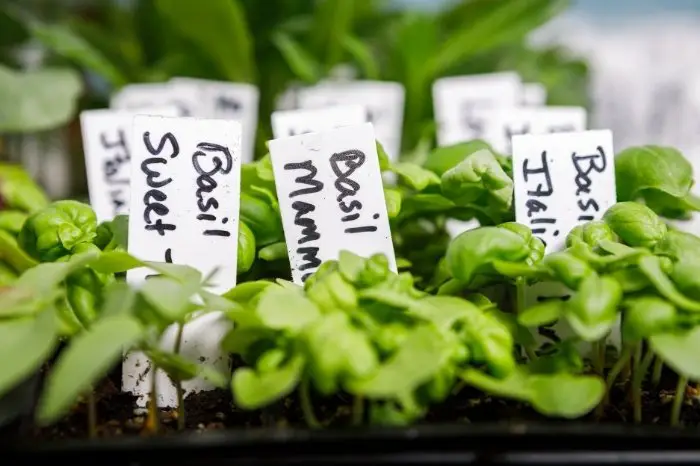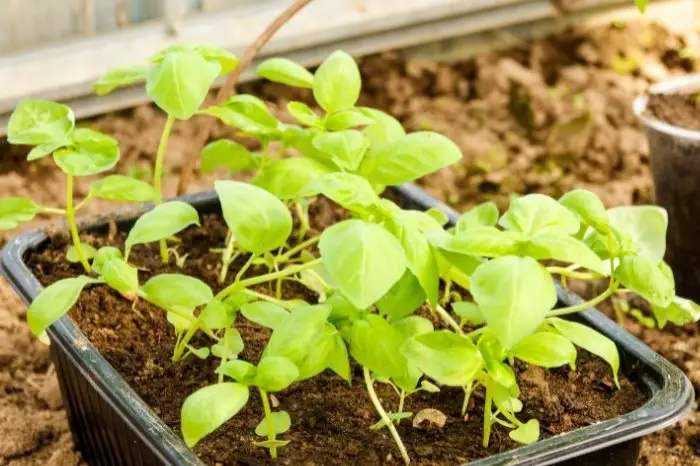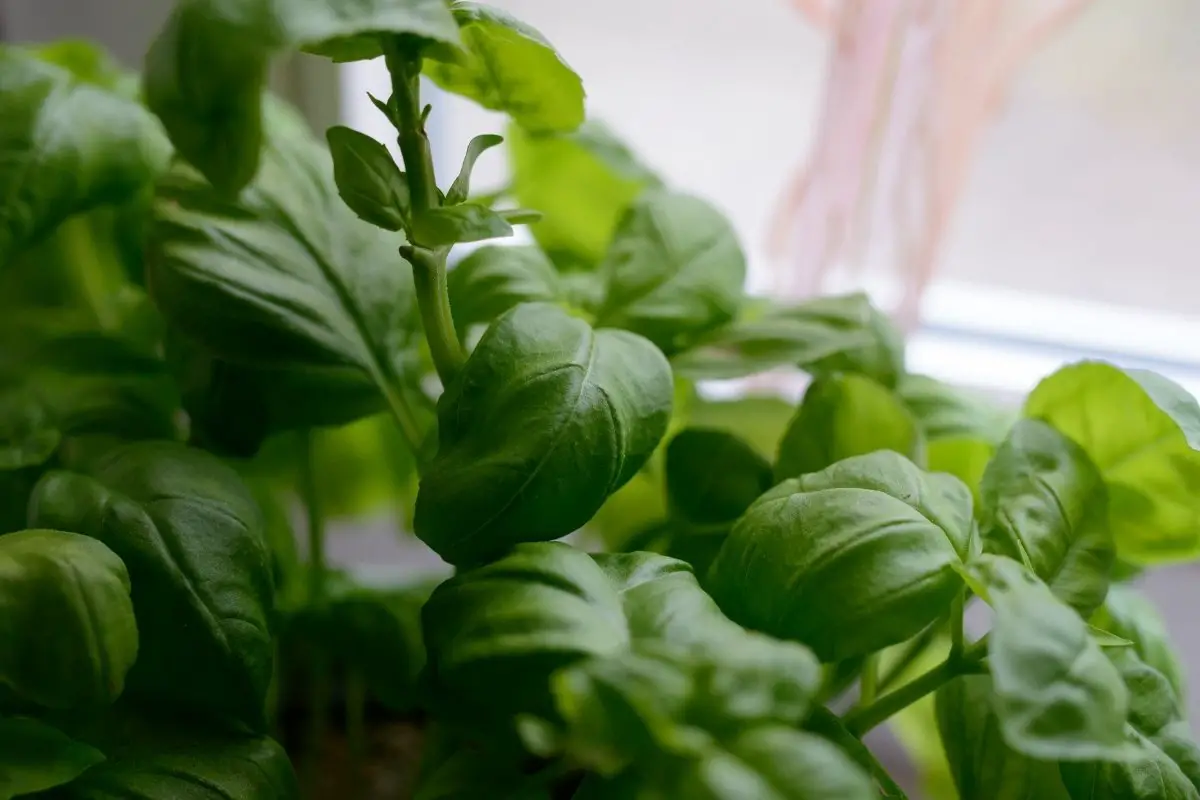Last Updated on January 17, 2023 by Urska
Can basil be grown indoors all year round, or is it only grown outdoors during the months that have no danger of snow?
Basil is an easy-to-grow herb that most gardeners enjoy growing. It is an essential and dynamic herb used in many different dishes.
Most home cooks enjoy the fact that they have easy access to fresh basil to elevate their skills in soups or tomato dishes. Innovative cooks utilize basil by making fritters out of the flower stalks, creating herbal vinegar dressings for salads, or seeping the leaves to make a refreshing tea drink.
Can Basil Be Grown Indoors?
The last thing that any gardener wants is to lose all the flavors of basil because it is the end of the growing season. However, these flavors and more can continue once the outdoor growing season has ended. Basil is an excellent plant to grow indoors. It does not need too much space, only a tiny sunny window seal, and it will successfully grow.
Growing basil inside extends its growing season, providing you with a full year of production. You will no longer need to run to the grocery store when a recipe needs fresh basil to get some. You can always grow basil indoors and another plant as a side benefit. Therefore, you will have an endless supply of this aromatic herb for your dishes. You will also share with family and friends all year round.

Various Ways Of How To Plant Basil Indoors
There are various ways of growing basil indoors; they include:
-
- Growing Basil in a Pot on a Sunny Window Sill. This method is the most common among most gardeners and is ideal for limited space. Growing basil indoors on a window sill is low maintenance as it accesses sunlight directly. The downside of this method is that cold temperatures can get through the plant and shock your warm, loving basil. When there is no sun during the winter, you will need to move your base a few inches away from the window to minimize sudden temperature changes.
- Growing your Basil Plant Under a Grow Light with a Grow Tent. This method gives you complete control over the ideal temperature outside light and humidity for maximum growth. It is generally a mini greenhouse made for your basil. The disadvantage of this method is that it requires more space, depends on electricity, and requires a higher investment of buying the grow tent, fans, timers, grow lights, and monitoring equipment; however, once the system is set up, your basal will thrive.
- Growing Basil Indoors Using a Hydroponic System. This method requires a high-tech system that relies entirely on recycling water and nutrients. Hydroponics is gaining popularity among many gardeners because it is more water-efficient and yields higher than plants growing in soil. The disadvantage of hydroponics is that it depends on electricity and requires frequent fertilization making the initial investment cost go higher.
Click here to Learn More About:
Basil Plant Care Indoors
Once you choose the suitable method that suits your growing conditions, it is best to know what type of care to give your herbs. Growing your basil indoors is effortless, mainly as long as you provide the right growing conditions.
Before growing your basil indoors, you will need to consider hours of light exposure, the temperatures, the soil moisture, nutrient requirements, and the containers to use. Let us look at the care required.
Lighting And Temperature
This is a big one because basil is a sun-loving plant.
If you’re using natural direct sunlight, such as a window sill, you will require an ideal location that receives at least six hours of sunlight. If you are in the Northern hemisphere, use a south-facing window as a perfect spot. For those in the Southern hemisphere, a north-facing window is ideal for plenty of sun exposure. Rotate your plants every couple of days to ensure even distribution of the sun and avoid growing leggy plants.
If you use grow lights, provide basal with 10 to 14 hours a day of light exposure. Depending on your grow light and how many plants are growing, you will need to ensure that your light does its job perfectly. Place your lights at least four to six inches above the young basil leaves and a little farther for mature plants.
The younger the plants, the more light they require. Younger plants require up to 16 hours of light so that they do not grow leggy and produce tiny leaves. If you notice their leaves have yellow or brown spots, the plants may be too close to the light source.
Basil plants prefer warm room temperatures for ideal indoor gardening. The ideal temperatures are 65 to 70 degrees Fahrenheit. Proper ventilation and airflow are essential for basil, significantly when growing tents. It is required that you have some form of air circulation fan that does not blow directly onto the plants.
If plants are blown directly, they are prone to drying out and slowing down their growth.
AeroGarden Harvest – Indoor Garden with LED Grow Light, Sage
Water And Humidity Requirements
Indoor basil plants love to have enough moisture in the soil. You will need to water your basal regularly but not too much. Be sure to drain any excess water sitting in the saucer when you water pot-grown basil. Young seedlings require more water than older ones, so water them more often. When growing basil in a hydroponic setting, you must change out your water every 1 to 2 weeks.
Basal requires humidity with their lives misted once or twice a week between waterings. You can fill a pebble tray with water and place it underneath the plant to provide evaporative humidity. The humidity range should be between 40 to 60% for your indoor Basil.
Growing Medium
Basal thrives indoors when you use a nutrient-dense potting mix. Potting mix provides proper drainage for your plant, which is not always the case when you’re using soil from your garden. The potting mix also minimises bringing in garden pests into your home. The alternatives of potting mix include commercial potting mix is that usually contain or that a-home blended potting mix such as coconut coir or peat moss. Labels are best used for hydroponics and are a tidy medium to use when growing basil indoors.
Fertilizing
You can add fertilizer to your basal as an essential food source. Rich potting soil provides enough nutrients to your basil plant. However, with time, the nutrients can deplete. Therefore, it is necessary to add a nutritious fertilizer, for example, blood meal or alfalfa meal, to your potting mix to ensure an ample supply of nitrogen throughout the plant’s growing season.
Basil is grown as an annual plant, but if you manage to coax them a little longer by adding a slow-release organic fertilizer, it will serve you longer than a year.

For hydroponics, use liquid nutrients as the only option. You will need to add nutrients every 7 to 10 days or as your system requires.
Pruning Basil Grown Indoors
Training is not a must for your basil plant; however, the basin responds well to regular harvesting and yields more leaves with a full bushy appearance. Wait until your basal is about 6 inches tall and print them off the main stem at least half an inch directly above a set of leaves. You can use your fingers to pinch off the stem but be careful not to tear the stem.
Prune every 2 to 3 weeks to control the shape of your basal. If you want to allow your basal to flower and go to seed, this will alter the flavor of your basal leaves, making them tough and bitter.
Conclusion
Can basil be grown indoors? Yes, by all means, you can grow basil indoors.
Indoor basil plants encounter a few diseases like downy mildew, root rot, bacterial leaf spot, and damping off. The earlier you notice these diseases, the better it is to administer treatment and save your plant.
Caroline is a gardener who loves to get down to the nitty–gritty of gardening. She proudly proclaims herself as a ‘dirt worshipper‘ and can often be found deep in the garden, covered in soil and singing to her plants. As a self–proclaimed ‘plant whisperer‘, Caroline believes that plants need love and attention just like any other living thing, and she loves to give them both. When she‘s not tending to her garden, you can often find her researching the latest gardening trends, or teaching others how to make their gardens thrive



